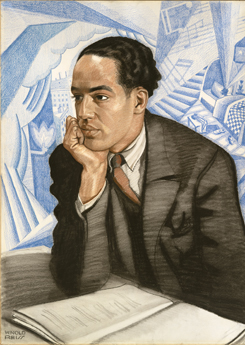7.12.24 — A Renaissance Finds Its Art
“Lift every voice and sing, / Till earth and heaven ring.” For two splendid decades after World War I, with Jim Crow still a vivid memory, there was a place for African Americans to believe in “a song of hope.”
What was the Harlem Renaissance, and where would a Renaissance be without painting? It must sound obvious, but even now people argue over the period’s legacy and its substance. With “The Harlem Renaissance and Transatlantic Modernism,” through July 28, not every voice is singing. Politics is largely absent, and jazz itself is all but silent. Modernism seems curiously far away.  Yet the Met makes an overdue case for its art—and it is the subject of a much longer and fuller review as my latest upload.
Yet the Met makes an overdue case for its art—and it is the subject of a much longer and fuller review as my latest upload.
You may think of the Harlem Renaissance as above all a literary movement, with Zora Neale Hurston and Jean Toomer in fiction, Countee Cullen in poetry, and Langston Hughes towering over both forms of expression. James Weldon Johnson, at the head of the NAACP, wrote of a “flowering of Negro literature.” You may think of it as a flourishing of theater, dance, and music, with such jazz greats as Duke Ellington, Fats Waller, Fletcher Henderson, and Bessie Smith—and Johnson himself composed hymns, including what some have called the black national anthem, “Lift Every Voice and Sing.” Or you may think of it as a broader intellectual achievement. It stands as a rebirth for black culture itself. Hubert Harrison spoke of the “New Negro” as early as 1917, and Alain Locke took that for the title of an anthology of fiction, poetry, and essays in 1925.
It was surely a rebirth for Harlem, neither the first nor the last. Harlem had served Dutch farmers and then city dwellers, as the first elevated trains headed uptown and a wave of European immigrants, many of them Jewish, sought affordable housing. Things changed once again in the twentieth century, as the Afro-Caribbean diaspora reached New York along with the Great Migration from the rural, racially oppressive South. Jazz came north from New Orleans with it, Louis Armstrong included, to found the swing era. The Apollo Theater had opened in 1914—improbably enough, for burlesque shows aimed at whites. It became the fabled venue for blacks only some twenty years later, thanks to a new Jewish owner.
The Met boasts right off of literary and cultural ferment. It opens with portraits of Locke and Hughes by Winold Reiss, Hurston by Aaron Douglas, and Johnson by Laura Wheeler Waring. Reiss, a German who found the rest of New York boring, brings his wiry black outlines broken only by the meticulous realism of his faces, suiting Locke’s hauteur and intellect. The pale patterned backdrop to Hughes hints at a ferment within painting itself, in early modern art. Douglas and Waring stick more closely to realism to flatter their subjects and their dignity. Then come portraits and street scenes, where ordinary men and women get to dress up, too.
The curator, Denise Murrell, is introducing not just a culture. She is assembling the artists who will render it. All three from that first room will turn up often, as will Archibald Motley and William H. Johnson. Motley brings the intensity of artificial light to equally unsettling narratives. Johnson has the brighter colors, flatter renderings, and impasto of folk art. Together, they set out the possibilities that other artists will explore, in a show of one hundred sixty works.
The show’s greatest pleasure is that it need not answer the charge. It can only keep looking for more. Sure, here Harlem itself lacks specifics, if not fashion sense. Yet a final room, easy enough to miss on the way out, does take to the street, for the eighteen feet of The Block, from 1971. Romare Bearden, then in his sixties, had been around the block, “Harlem on My Mind” was two years gone, and the Harlem Renaissance was history. The mural’s triumph may drive home the movement’s limits—or its importance for the future.
Read more, now in a feature-length article on this site.